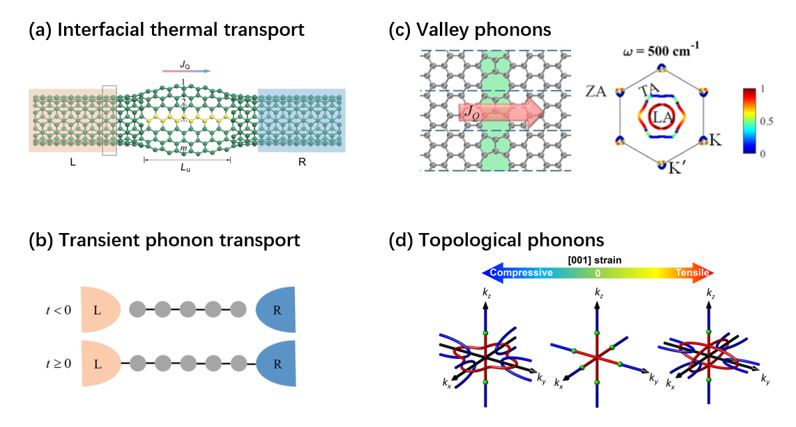Video Article Open Access
Quantum Thermal Transport in Low-Dimensional Nanomaterials
Xiaobin Chen1,*, Y. Liu2, Y. Xu2
1Harbin Institute of Technology, Shenzhen 518055, China
2State Key Laboratory of Low Dimensional Quantum Physics, Department of Physics, Tsinghua University, Beijing 100084, China
Vid. Proc. Adv. Mater., Volume 3, Article ID 2211377 (2022)
DOI: 10.5185/vpoam.2022.11377
Publication Date (Web): 27 Nov 2023
Copyright © IAAM
Graphical Abstract

Abstract
Changing dimensions and making nanostructures can greatly alter phonon structures of materials. By combining first-principles calculation and phonon nonequilibrium Green’s function (NEGF) method, we investigated theoretically thermal transport properties of low-dimensional nanostructures. In this talk, I shall briefly introduce four works: 1. Interface scattering in partially-unzipped carbon nanotubes for tuning phonon conduction. We found that thermal conductance of PUCNTs shows nearly perfect linear scaling law against unzipping length, and exponentially decreases to a nonzero value as unzipping length increases. By using a 1D chain model, we succeeded to reveal that linear scaling comes from mode restriction, and exponential law from matching between phonon modes. 2. Transient thermal conduction: We developed a closed-form formula to calculate the transient thermal currents flowing through an arbitrary nanoscale phonon device in response to a sudden thermal switch. Our theory provides a solution to the problem in the far-from-equilibrium nonlinear response regime beyond the wide-band-like approximation and Drude regularization. We presented calculations in a one-dimensional monatomic chain with Lorentzian-like thermal baths and show that the transient phonon currents are significantly larger than the long-time-limit steady-state phonon current. From the formula’s clear mathematical structure, we also showed that the transient oscillation periodicity and relaxation time are determined by the poles of the retarded phonon Green’s function. Our results suggested that ultrafast cooling of nanodevices through transient phonon currents is a promising route. 3. Valley phonons: Due to their possibility to encode information and realize low-energy-consumption quantum devices, control and manipulation of the valley degree of freedom have been widely studied in electronic systems. In contrast, the phononic counterpart—valley phononics—has been largely unexplored, despite the importance in both fundamental science and practical applications. In this work, we demonstrated that the control of “valleys” is also applicable for phonons in graphene by using a grain boundary. In particular, perfect valley filtering effect sis observed at certain energy windows for flexural modes and found to be closely related to the anisotropy of phonon valley pockets. Moreover, valley filtering may be further improved using Fano-like resonance. Our findings revealed the possibility of valley phononics, paving the road towards purposeful phonon engineering and future valley phononics. 4. Our ab initio calculations identified silicon as an ideal candidate material containing extraordinarily rich topological phonon states. In silicon, we found various topological nodal lines characterized by quantized Berry phase π, which gives drumhead surface states observable from any surface orientations. Remarkably, a novel type of topological nexus phonon was discovered which was featured by double Fermi-arc-like surface states but requires neither inversion nor time-reversal symmetry breaking. Versatile topological states can be created from the nexus phonons, such as Hopf nodal links by strain. Furthermore, we generalized the symmetry analysis to other centrosymmetric systems and find numerous candidate materials, demonstrating the ubiquitous existence of topological phonons in solids. These findings open up new opportunities for studying topological phonons in realistic materials and their influence on surface physics.
Keywords
Nonequilibrium Green’s function (NEGF); quantum thermal transport; transient phonon current.
Acknowledgement
We gratefully acknowledge financial support by NSF-China [Grant Nos. 12074091 and 11704257 (X.C.)]. We gratefully acknowledge HZWTECH for providing computation facilities.
References
- X. Chen, Y. Xu, X. Zou, B.L. Gu, W. Duan, Phys. Rev. B., 2013, 87, 155438.
- X. Chen, Y. Xu, J. Wang, H. Guo, Phys. Rev. B., 2019, 99, 064302.
- Y. Liu, X. Chen, Y. Xu, Adv. Funct. Mater., 2020, 30, 1904784.
- X. Chen, J. Yuan, J. Wang, Phys. Rev. B., 2021, 103, 075427.
- Y. Liu, N. Zou, S. Zhao, X. Chen, Y. Xu, W. Duan, Nano Lett., 2022, 22, 2120.
Video Proceedings of Advanced Materials

Upcoming Congress



